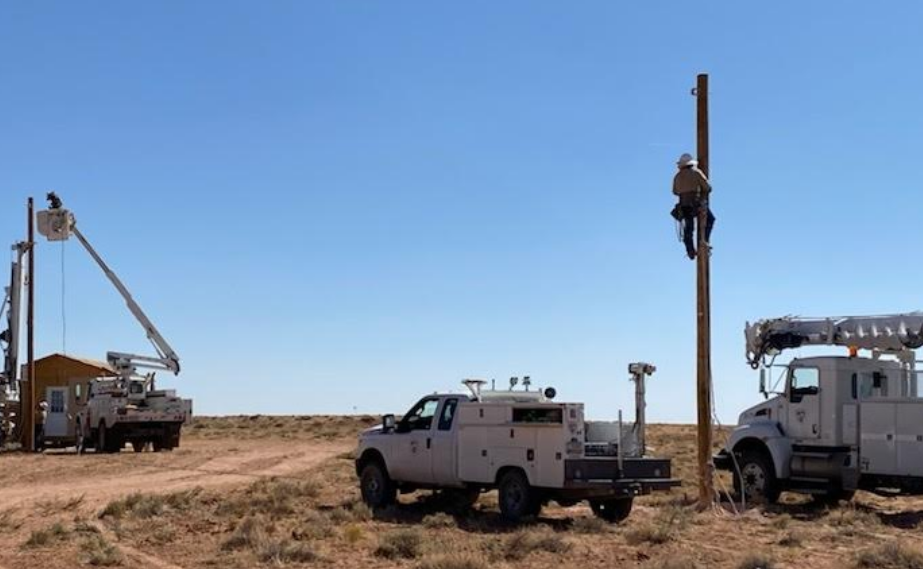
- Details
- By Native News Online Staff
WINDOW ROCK, Ariz. — The Covid-19 pandemic has heightened awareness of the lack of running water, electricity and broadband on the Navajo Nation Indian Reservation, the country’s largest that encompasses 27,000 square miles in Arizona, New Mexico and Utah.
On Oct. 9 the Navajo Tribal Utility Authority (NTUA) updated Navajo Nation President Jonathan Nez and Vice President Myron Lizer on the use of CARES Act funds, which indicates that NTUA has now connected 260 homes to the electric grid, upgraded 32 water wells, continues to install up to 150 water cisterns system.
Navajo Nation leadership were informed the NTUA continues to make progress using CARES Act funds.
NTUA utility crews continue to work 10-hour days, weekends, and holidays to complete projects. NTUA is planning to extend electricity to 510 families, which includes over 350 families that were identified during the 2020 LIGHT UP NAVAJO II application process. In addition, NTUA continues to accept applications from residents for its residential solar program, which was allocated $35.1 million in CARES Act funds. For more information about eligibility for the solar program, please visit www.ntua.com under CARES Act-NTUA Projects.
“On behalf of the Navajo Nation, we thank NTUA for being an example for all of us in terms of working through the red tape to expedite projects for the benefit of the Navajo people. It’s unfortunate that NTUA has not received all its CARES Act dollars from the Office of the Controller, but they have stepped up to use their own funds to front the cost of these projects. We’ve met with the Office of the Controller and indicated the need to transfer those funds immediately. To all of the men and women working long hours, seven days a week, to move these projects forward, we thank you and we want you to know that you are making a lasting impact on your communities and Navajo people,” President Nez said.
In August, the 24th Navajo Nation Council and the Nez-Lizer Administration approved $13.8 million for power line projects, $24.7 million to increase overall electric grid capacity, $20.9 million for cisterns systems, $18.6 million for wastewater systems, and $32.8 million for wireless and broadband expansion for NTUA from the Navajo Nation’s CARES Act funds.
Among numerous water projects, NTUA utility crews renovated, upgraded, and/or installed six regional watering loading stations in the communities of Bodaway-Gap, Leupp, Lupton, Torreon, Lake Valley, and Wide Ruins, which are now open for public use. Renovations and upgrades are also in progress in Chilchinbeto, Inscription House, Whitecone, Kin Dah Lichíí, and Pueblo Pintado.
The replacement of motors and pumps for up to 42 targeted water wells and working with Navajo Engineering and Construction Authority to install 150 water cistern systems where there is no water available for household drinking water, and bathroom and kitchen usage. Other projects include renovations and upgrades of regional water stations, construction of several new watering points, converting off-line-wells to watering loading stations for livestock, water well renovations, replacement of exposed water lines, and more.
NTUA has also established 33 free wi-fi hotspots in various communities across the Navajo Nation to help students, parents, and teachers with online learning. NTUA and NTUA Choice Wireless are assessing the possibility of installing additional wifi hotspots due to increased demand and usage. NTUA is also awaiting the arrival of new materials and equipment to construct new towers in several communities. The latest wifi hotspot to go live is located at the Shiprock fairgrounds.
Overall, the Navajo Nation received over $714 million in CARES Act funds: $600 million on May 6, $86 million on June 16, and $27 million on June 18. Approximately $537 million in CARES Act funds has been approved and signed into law, leaving a remaining amount of $176 million.
More Stories Like This
Native News Weekly (August 25, 2024): D.C. BriefsUS Presidents in Their Own Words Concerning American Indians
Two Murdered on Colville Indian Reservation
NDAA passes House; Lumbee Fairness Act Advances
NFL, Vikings to Host Native All-American Game, Youth Flag Clinic
Help us defend tribal sovereignty.
At Native News Online, our mission is rooted in telling the stories that strengthen sovereignty and uplift Indigenous voices — not just at year’s end, but every single day.
Because of your generosity last year, we were able to keep our reporters on the ground in tribal communities, at national gatherings and in the halls of Congress — covering the issues that matter most to Indian Country: sovereignty, culture, education, health and economic opportunity.
That support sustained us through a tough year in 2025. Now, as we look to the year ahead, we need your help right now to ensure warrior journalism remains strong — reporting that defends tribal sovereignty, amplifies Native truth, and holds power accountable.
 The stakes couldn't be higher. Your support keeps Native voices heard, Native stories told and Native sovereignty defended.
The stakes couldn't be higher. Your support keeps Native voices heard, Native stories told and Native sovereignty defended.
Stand with Warrior Journalism today.
Levi Rickert (Potawatomi), Editor & Publisher

